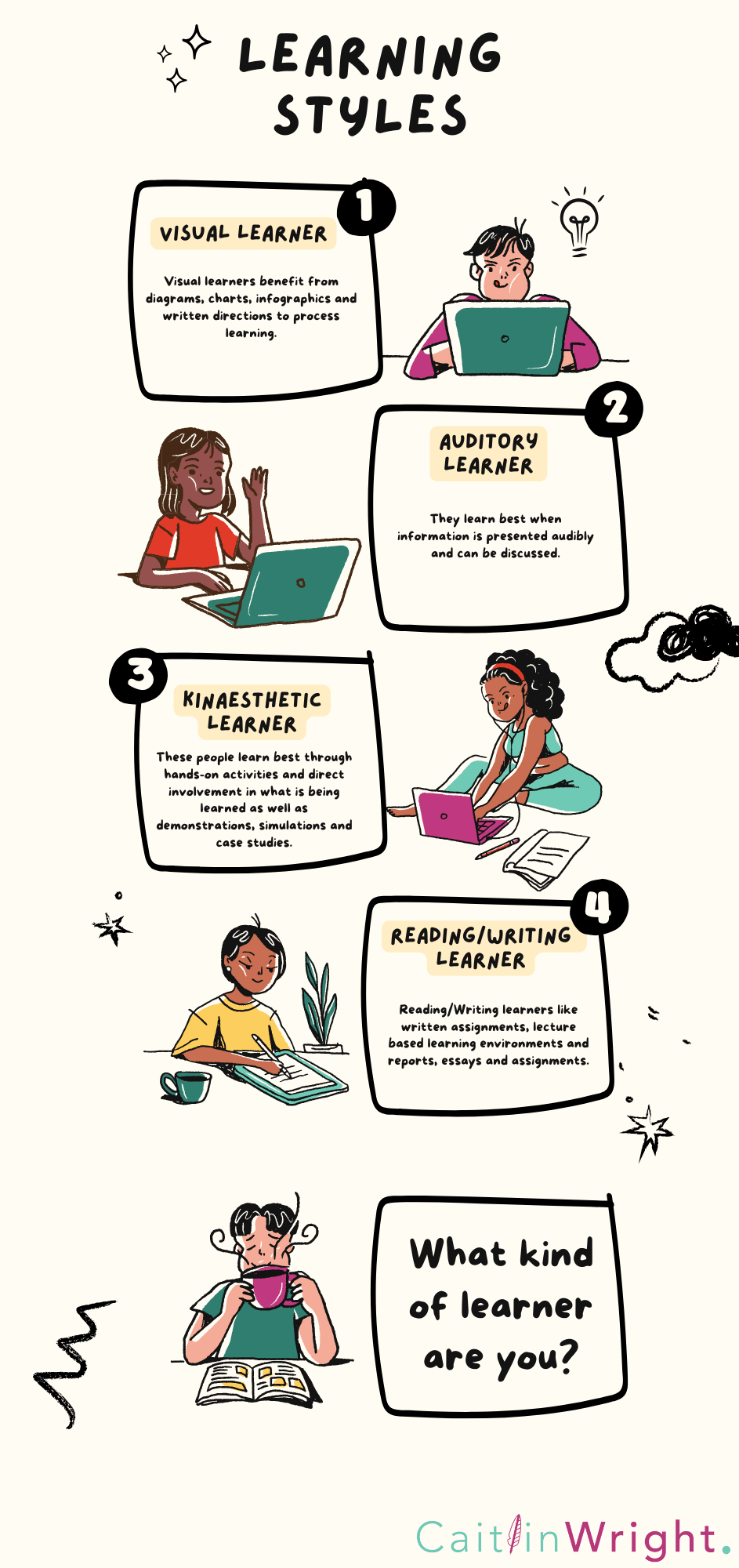I’m knee deep into writing a white paper at the moment and one of the topics included is learning styles. I’m sure the educators among us would know a heap about this and understand the many different learning styles that are debated.
But I’m embarrassed to admit that I hadn’t really thought much about it and had never really analysed my own learning style. The more I think about it though, the more I realise that as copywriters, we should consider different learning styles to appeal to various audiences.
What are learning styles?
Learning styles are a theory that proposes that people have a preferred method or style of learning that works best for them. There are many critiques of this theory as learning is nuanced, ever evolving, and it continues to be debated.
However, one learning style theory continues to see prominence was developed by Neil Fleming in 1987. Called the VARK model of learning, Fleming believed we are all one of four main types of learnings: visual, auditory, reading/writing and kinaesthetic.
Visual – Learners who prefer using images, pictures, colours, and maps to organise information and communicate with others. Visual learners benefit from diagrams, charts, and written directions.
Auditory – These learners prefer using sound, rhythms, music, recordings, and lectures. They learn best when information is presented audibly and can be discussed.
Reading/Writing – Learners prefer using words, both in speech and writing, to absorb information. They like written assignments, lecture based learning environments and reports, essays and assignments.
Kinaesthetic – Learners who prefer using their bodies, hands, and sense of touch. They learn best through hands-on activities and direct involvement in what is being learned, as well as demonstrations, simulations and case studies.
People don’t necessarily have just one style they like. It might depend on what they’re learning or also on how they’re feeling. It may come as no surprise, but my favourite learning style is reading/writing. I am the type of person who would prefer to read the subtitles, or a transcript of a video rather than just listen to it.
I also like the kinaesthetic style of learning. In high school and uni, I spent hours and hours doing practise exam papers rather than studying diagrams and highlighting phrases in a book. I often enjoy just getting started on something and work it out as I go along.

How learning styles can be integrated into copywriting?
When we’re writing a piece of copy, whether through a website, blog or even LinkedIn post, we’re educating our audience about what we want to say. So it makes sense to consider learning styles in our copywriting. But how can we do it? Here are some ideas.
Visual learners
Visual learners absorb information best through images, charts, and diagrams. For a copywriter, this means we could use lots of images and diagrams complementing the text. Infographics, relevant photographs, and branded graphics can turn a plain text message into an engaging piece of content that captures attention and makes complex information easier to digest.
A copywriter working on a website’s content might use banner images or break up text with visuals to enhance readability and appeal to visual learners.
Auditory learners
They prefer listening to information, so podcasts and video content are key formats for engaging this group. Copywriters might not directly create audio content, but they can write scripts for videos and podcasts that are meant to inform, entertain, or persuade. They might suggest a video to be on the homepage or the clients set up a podcast to accompany their messaging.
Additionally, using rhythmic, memorable phrasing can make the text itself more appealing to auditory learners when read aloud.
Kinaesthetic learners
They thrive on doing and feeling. While this can be challenging to address directly in copywriting, interactive elements like clickable ads, interactive infographics, or content that encourages physical interaction (like printable worksheets or DIY guides) can make digital content more engaging for kinaesthetic learners.
Copywriters can also create content that prompts action, such as step-by-step guides or tutorials that encourage readers to participate in activities.
Reading/writing learners
This is mainly where most copywriters can help. Learners who favour this style prefer information displayed as words. Effective copywriting that caters to this style focuses on well-structured, clear, and concise text. Blog posts, articles, white papers, and eBooks are ideal formats for these learners.
Copywriters, like myself, who favour this style naturally excel in creating detailed written content that explains, persuades, and informs through text.
How can learning styles improve your messaging?
When you look at how these educational concepts influence content creation, it can lead to more effective marketing strategies and campaigns. It shows a commitment to addressing the diverse ways in which potential customers interact with content, ultimately enhancing engagement and conversion rates.
Fortunately, many of these aspects also align with best practice for website writing. By employing strategies like those used in educational settings, we can meet the audience where they are, leading to deeper connections and more impactful communications.
What’s your preferred learning style?

